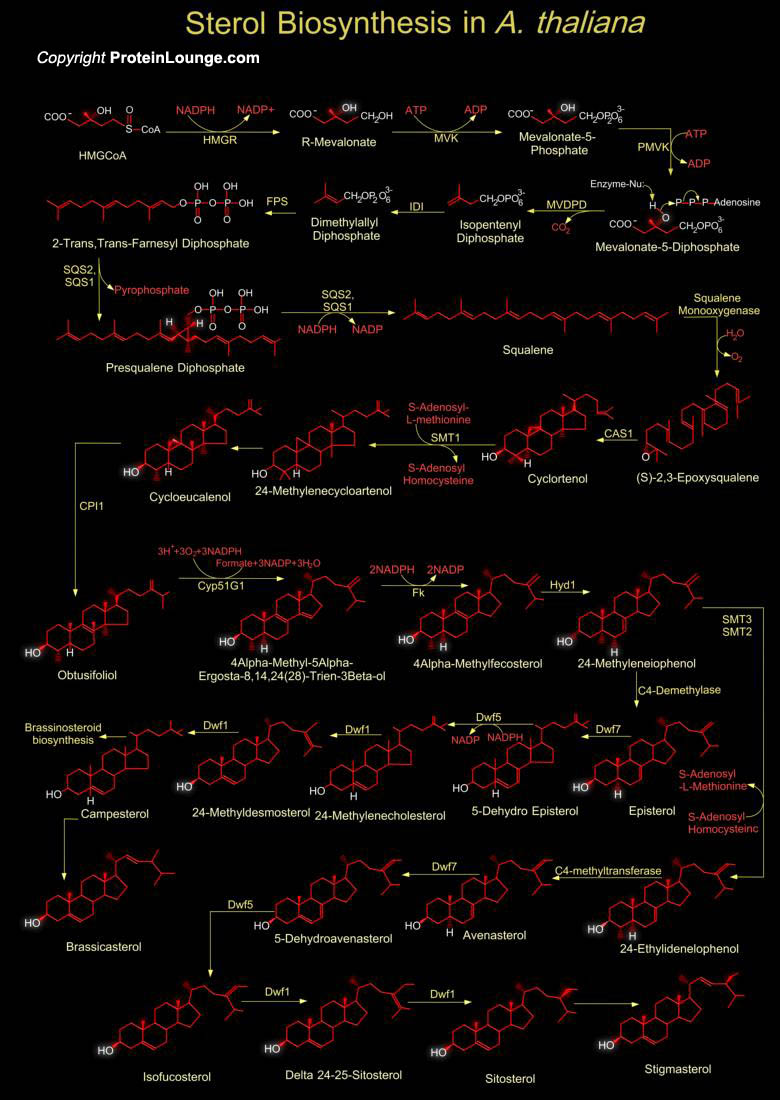
Sterols are a structurally conserved class of lipids that play multifaceted roles in Eukaryotes, serving as essential components of Cell membranes and precursors to Steroid hormones. Characterized by a –OH group on the C3 of the Steroid nucleus, Sterols represent the most abundant type of Steroids in Vertebrates as well as in Plants. In Vertebrates, Cholesterol is by far the major Sterol, whereas a mixture of various Sterols is present in higher plants. The major Sterol is typically Sitosterol, followed by Campesterol, Stigmasterol, and various minor sterols like Isofucosterol, Brassicasterol and Cholesterol. Functional roles for the Campesterol-derived BRs (Brassinosteroids) are established for integrating light signals in the regulation of postembryonic plant[..]
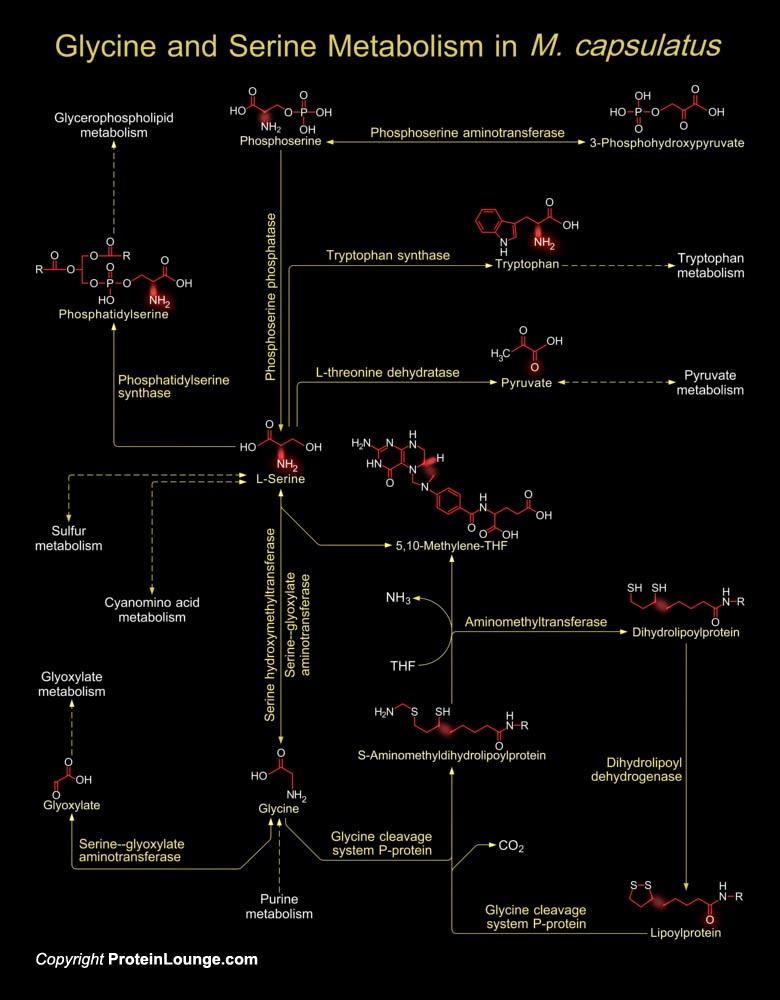
Methylococcus capsulatus is an obligate, Gram-negative methanotroph. It generally use the greenhouse gas Methane as a sole carbon and energy source for growth, thus playing major roles in global carbon cycles, and in particular, substantially reducing emissions of biologically generated Methane to the atmosphere. Methylococcus capsulatus is the first complete genome sequence reported from an obligate methanotroph. Genome analysis suggests the ability of M. capsulatus to scavenge copper (including a previously unreported nonribosomal peptide synthetase) and to use copper in regulation of methanotrophy, but the exact regulatory mechanisms remain unclear. The existence of previously unsuspected metabolic flexibility in M. capsulatus, including an ability to grow on[..]
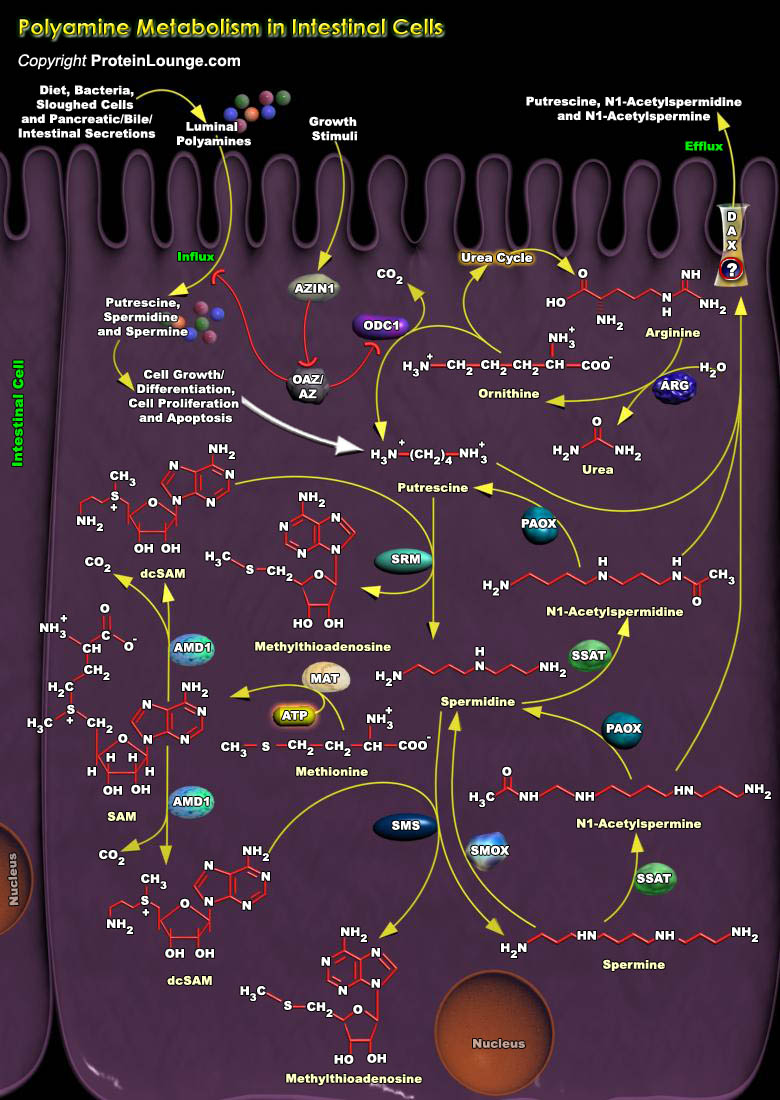
The amino-acid derived polyamines have long been associated with cell growth and cancer, and specific oncogenes and tumor suppressor genes regulate polyamine metabolism. Polyamines are organic cations that are derived from amino acids and occur in all organisms. Putrescine, Spermidine and Spermine are the main polyamines found in prokaryotes and eukaryotes. Polyamines are essential for the growth and function of normal cells. They interact with various macromolecules, both electrostatically and covalently and, as a consequence, have a variety of cellular effects. At physiological pH, polyamines carry a positive charge on each nitrogen atom and it has been suggested that polyamines are simply ‘supercations’, equivalent to one or two calcium or magnesium[..]
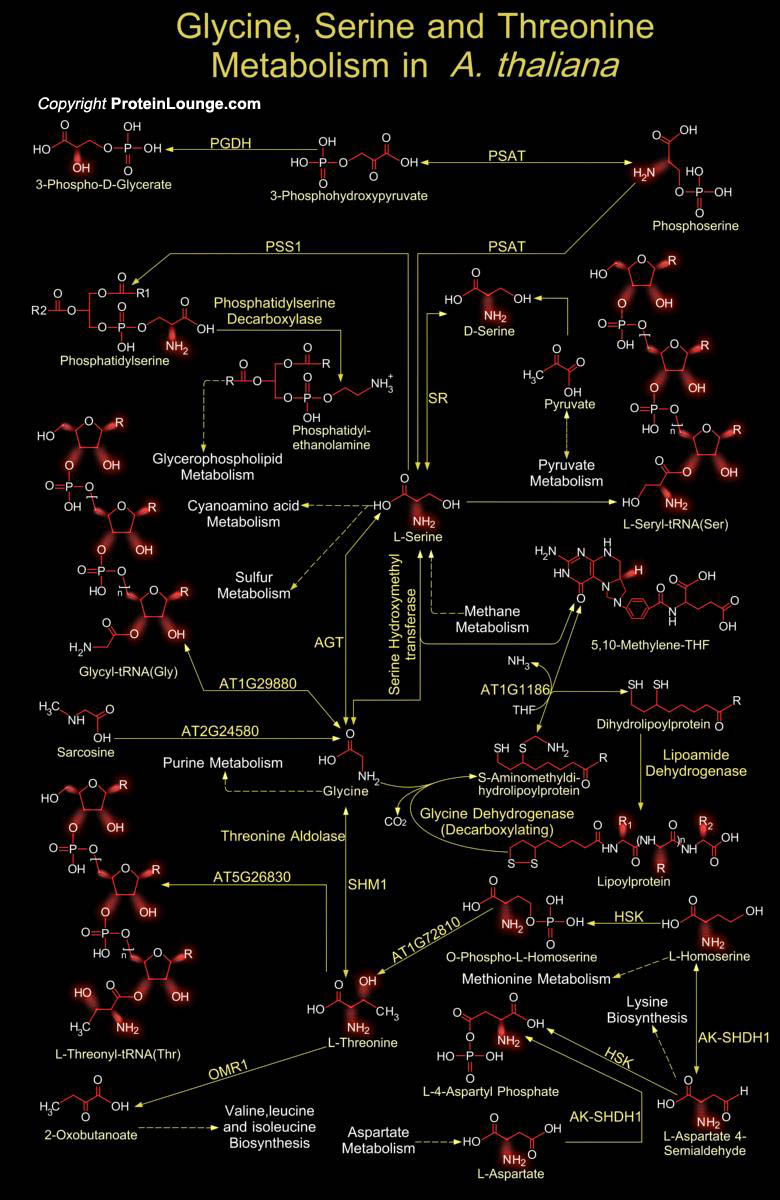
Amino acids are not only the building blocks of proteins, but also serve as precursors for other important plant metabolites and constitute an essential part of human and animal diets. The biosynthesis and degradation of the twenty standard Amino acids represent the complexity and ingenuity of metabolism at its most astounding. Plants are able to generate all 20 Amino acids necessary for protein synthesis by themselves. They do even synthesize some more Amino acids. Glycine and Serine are two Interconvertible Amino acids that play an important role in C1 metabolism. Glycine is the simplest Amino acid and is the only Amino acid that is not optically active. On a molar basis, Glycine is the second most common Amino acid found in proteins and enzymes being[..]
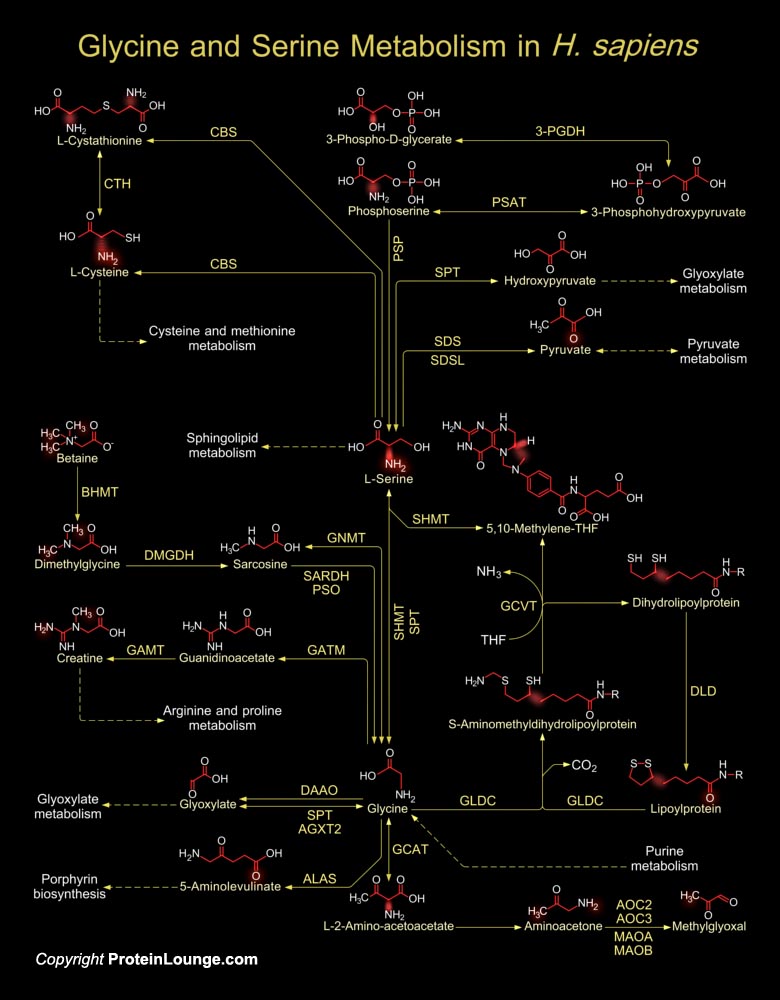
Glycine and Serine are two non-essential amino acids in humans, which have important roles in the Central Nervous System. Serine, a constituent of brain proteins and nerve coverings, is important in various processes like dendritic outgrowth, formation of cell membranes, metabolism of Purines and Pyrimidines, Myelin formation and muscle synthesis, synthesis of nucleotides and neuroactive amino acids like D-Serine and Glycine. As a building block of proteins and membrane lipids, it is required for metabolism of fats, cell and tissue growth and in the immune system, it assists in the production of immunoglobulins/antibodies. Serine derivatives are important components of the membrane phospholipids, whereas Glycine is the simplest, optically inactive, and the second most[..]
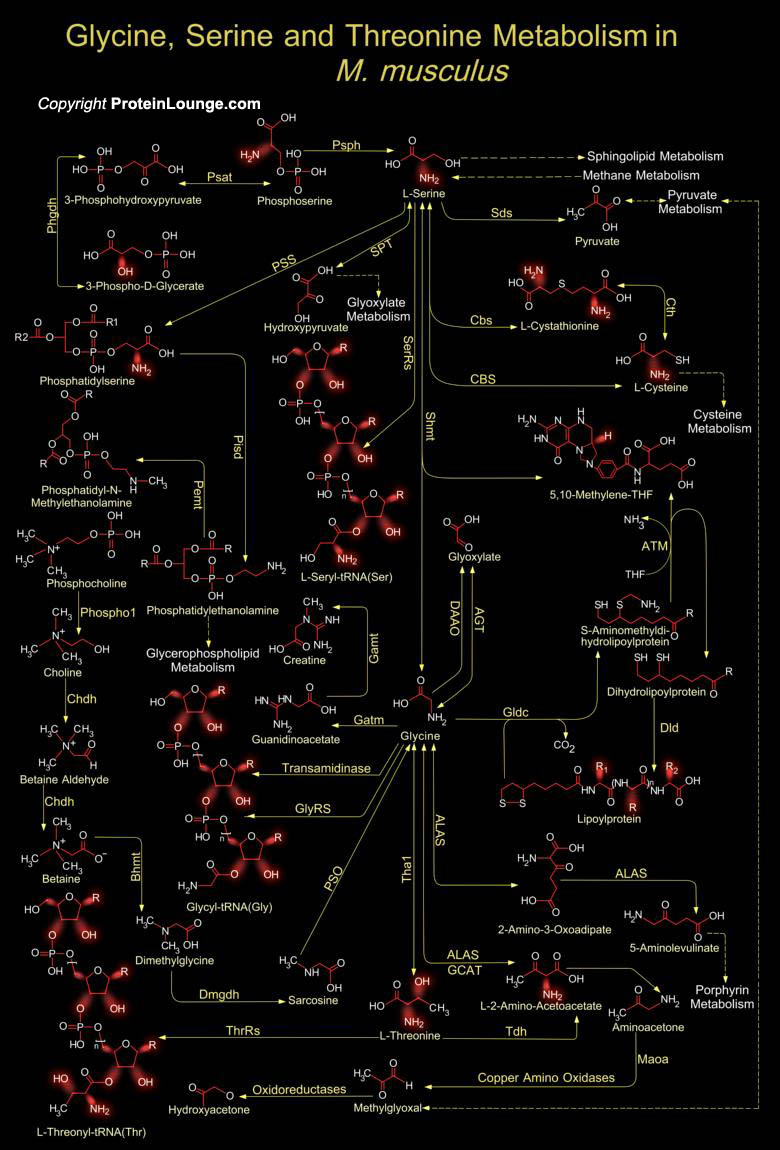
Glycine and Serine are two non-essential neurotrophic amino acids that play an essential role in neuronal development and function in M. musculus (Mus musculus). They share similar neurotrophic effects in promoting neuronal survival and differentiation of sensory ganglia, hippocampal neurons, and cerebellar Purkinje cells. In M. musculus, interplay between Glycine and Serine in a co-existence with L-Threonine represent a major metabolic crossroad that links several other biological pathways of immense importance. L-Serine serves as a building block of proteins, and is of vital importance for the syntheses of L-Cysteine, Phosphatidyl-L-Serine, nucleotides, and the neuromodulators D-Serine and Glycine (Ref.1). L-Serine is a precursor for the synthesis of membrane[..]
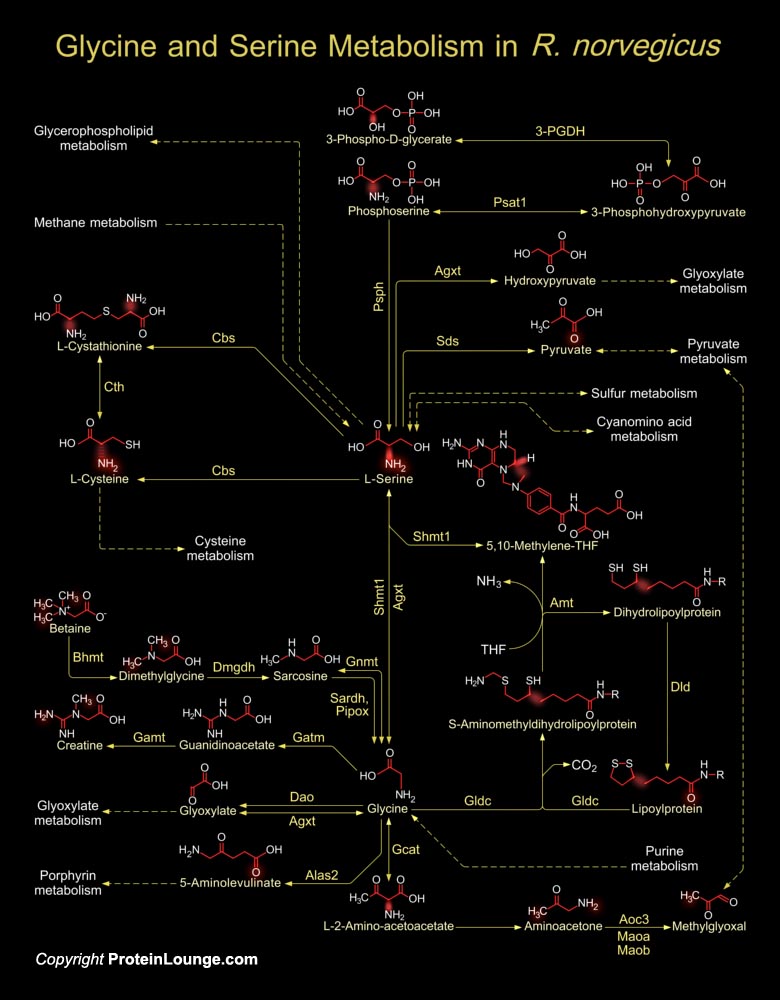
Glycine and Serine are two interconvertible non-essential amino acids found abundantly in almost all cell types. They serve as active ligands for many metabolic pathways where they aid in the synthesis of other essential metabolites, such as Glycogen, Glyoxylate and Pyruvate, which are of immense importance for many cellular and biological processes. The metabolic pathway that correlates Glycine and Serine in R. norvegicus (Rattus norvegicus) has a relation with metabolism of the indispensable amino acid Threonine (Ref.1).L-Serine is a major source of one-carbon units in mammals. It serves as a building block for protein synthesis and is modified in different metabolic pathways for the generation of several essential compounds, such as Glycine, D-Serine, Cysteine,[..]
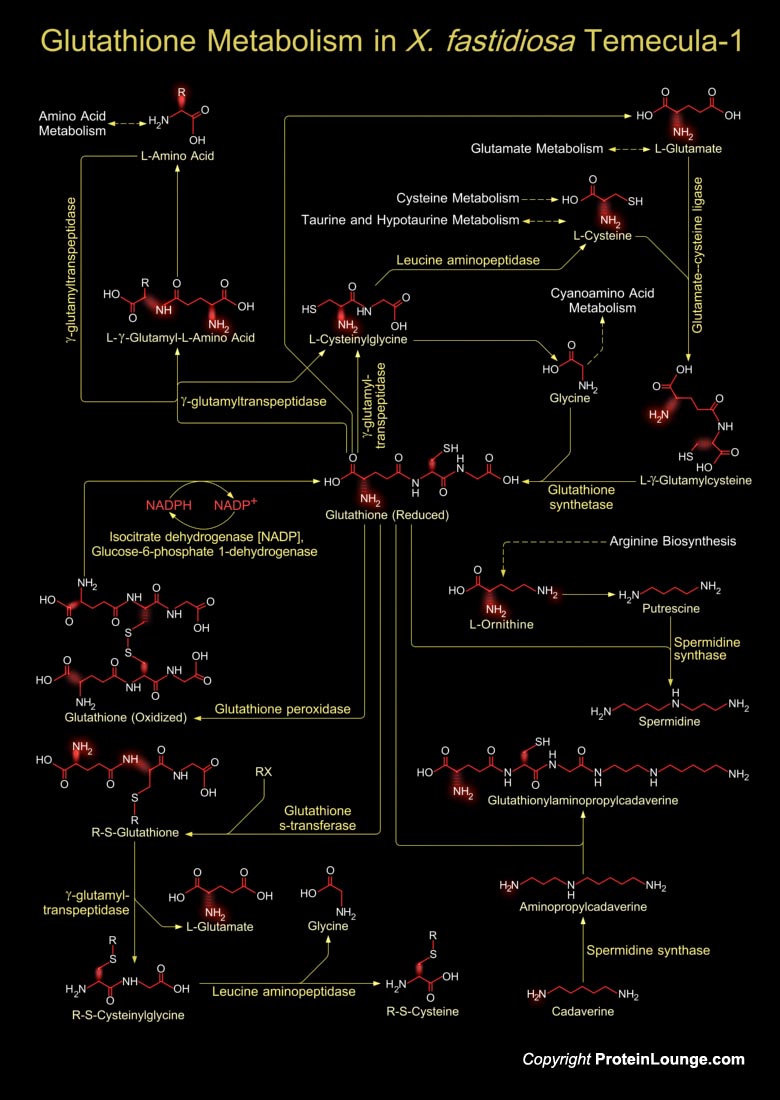
Xylella fastidiosa is a Gram-negative, fastidious, xylem-limited bacterium that causes a range of economically important plant diseases. It causes citrus variegated chlorosis-a serious disease of orange trees. It is responsible for pathogenicity and virulence involving toxins, antibiotics and ion sequestration systems (Ref.1 & 2). X. fastidiosa Temecula-1 is 2.52MB. It is isolated from a naturally infected grapevine with Pierce's disease in a wine-grape-growing region of California. This disease is characterized by wilted, shriveled, raisin-like fruits and scorched leaves that detach, leaving bare petioles attached to the canes. This devastating disease is a major threat to the viability of the California wine industry (Ref.3).Glutathione is a tripeptide[..]
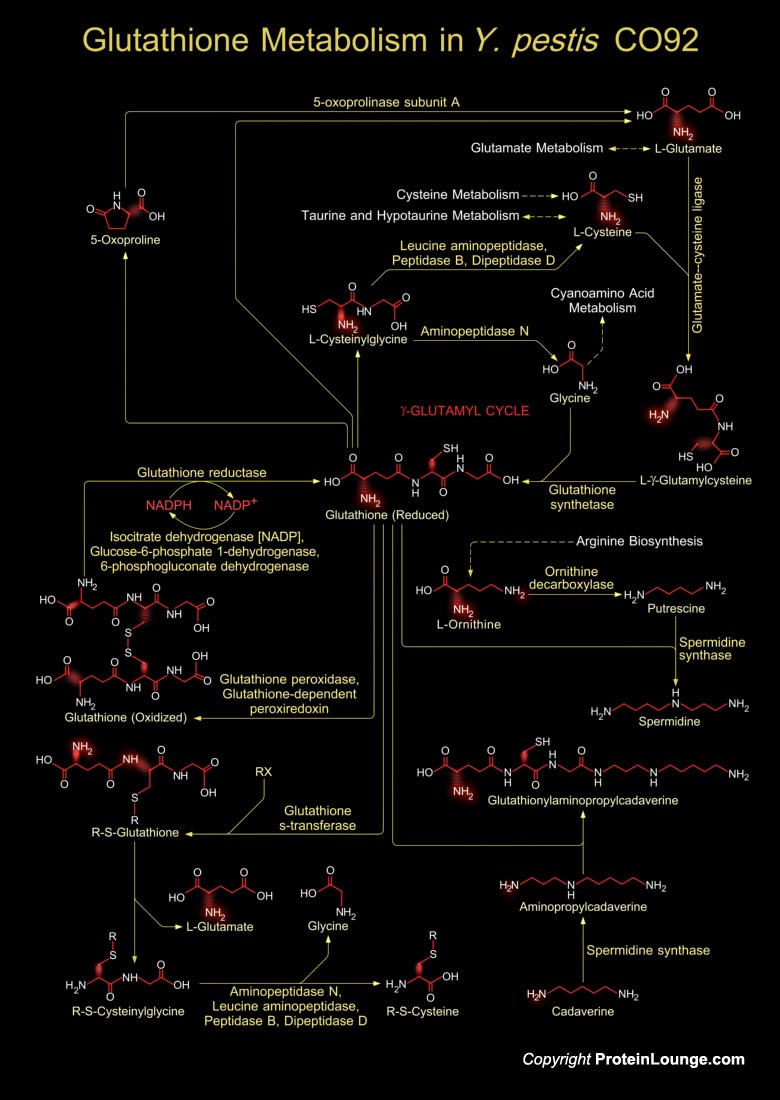
Yersinia sp. is responsible for disease syndromes ranging from gastroenteritis to plague. Y. pestis is categorized into three subtypes or biovars; Antiqua, Mediaevalis, and Orientalis, each associated with a major pandemic. Y. pestis strain CO92 belongs to biovar Orientalis that are responsible for the current pandemic (modern plague). Glutathione is a tripeptide present in Yersinia sp., which is composed of Glutamate, Cysteine and Glycine, and has numerous important functions within cells. The tripeptide is the thiol compound, present in the highest concentration in all types of cells (Ref.1).Glutathione metabolism in Y. pestis involves both the synthesis of Glutathione and its catabolism. Glutathione biosynthesis starts from 5-Oxoproline (OP) the lactam of[..]
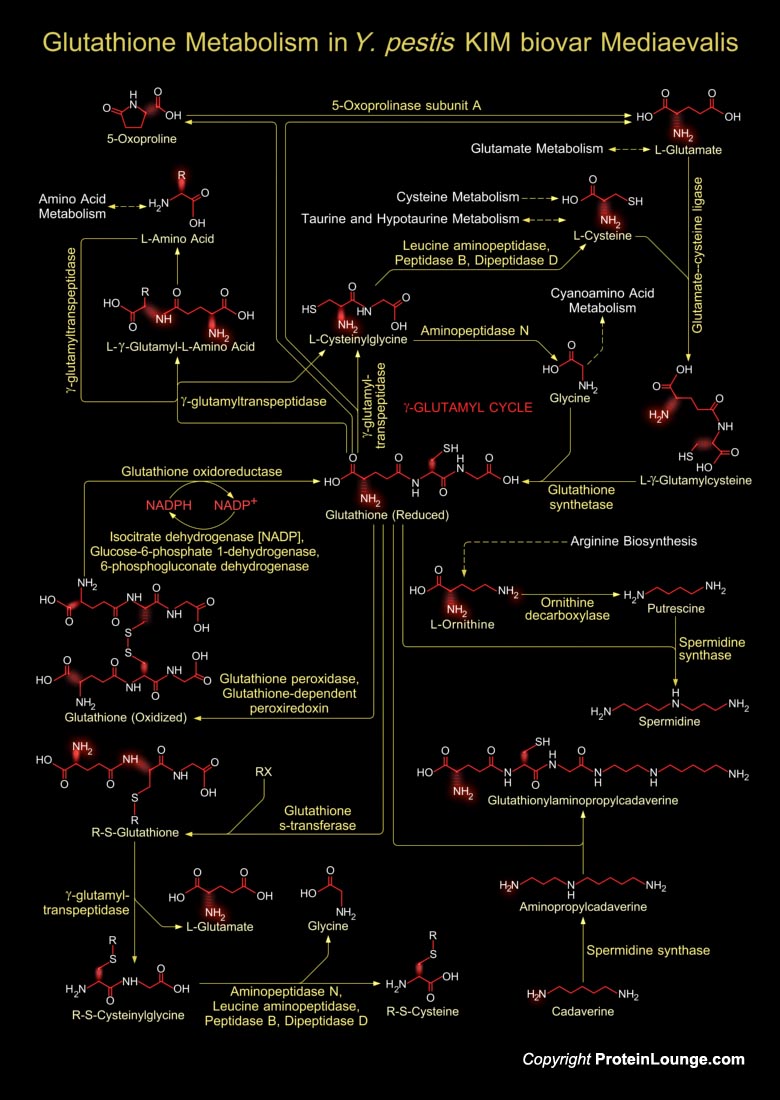
Glutathione is a tripeptide present in Yersinia sp., which is composed of Glutamate, Cysteine and Glycine, and has numerous important functions within cells. Yersinia sp. is responsible for disease syndromes ranging from gastroenteritis to plague. Y. pestis is categorized into three subtypes or biovars; Antiqua, Medievalis, and Orientalis, each associated with a major pandemic. The strain Y. pestis KIM belongs to biovar Mediaevalis and is associated with the second pandemic, including the Black Death (Ref.1).Glutathione metabolism in Y. pestis involves both the synthesis of Glutathione and its catabolism. Glutathione biosynthesis starts from an L-Amino acid, which in presence of the enzyme Gamma-GT (Gamma-Glutamyltranspeptidase) forms L-Gamma-Glutamyl-L-Amino acid and[..]
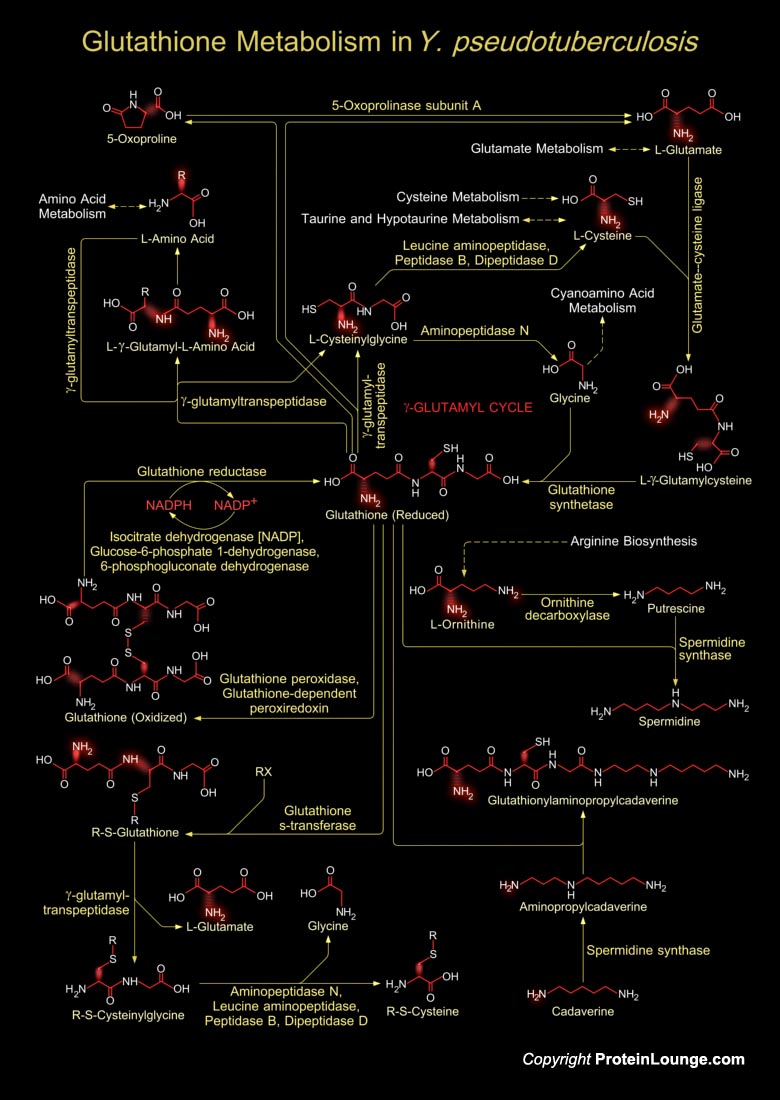
Yersinia sp. is responsible for disease syndromes ranging from gastroenteritis to plague. Y. pestis is categorized into three subtypes or biovars; Antiqua, Mediaevalis, and Orientalis, each associated with a major pandemic. Yersinia pseudotuberculosis is the least common of the three main Yersinia species to cause infections in humans. It is primarily a zoonotic infection with variable hosts, including domestic and sylvatic animals. The condition has been associated with food-borne infection, including a few outbreaks. The organism primarily leads to a gastroenteritis (diarrheal component uncharacteristic) characterized by a self-limited mesenteric lymphadenitis mimicking appendicitis. Postinfectious complications include erythema nodosum and reactive arthritis. Thus,[..]
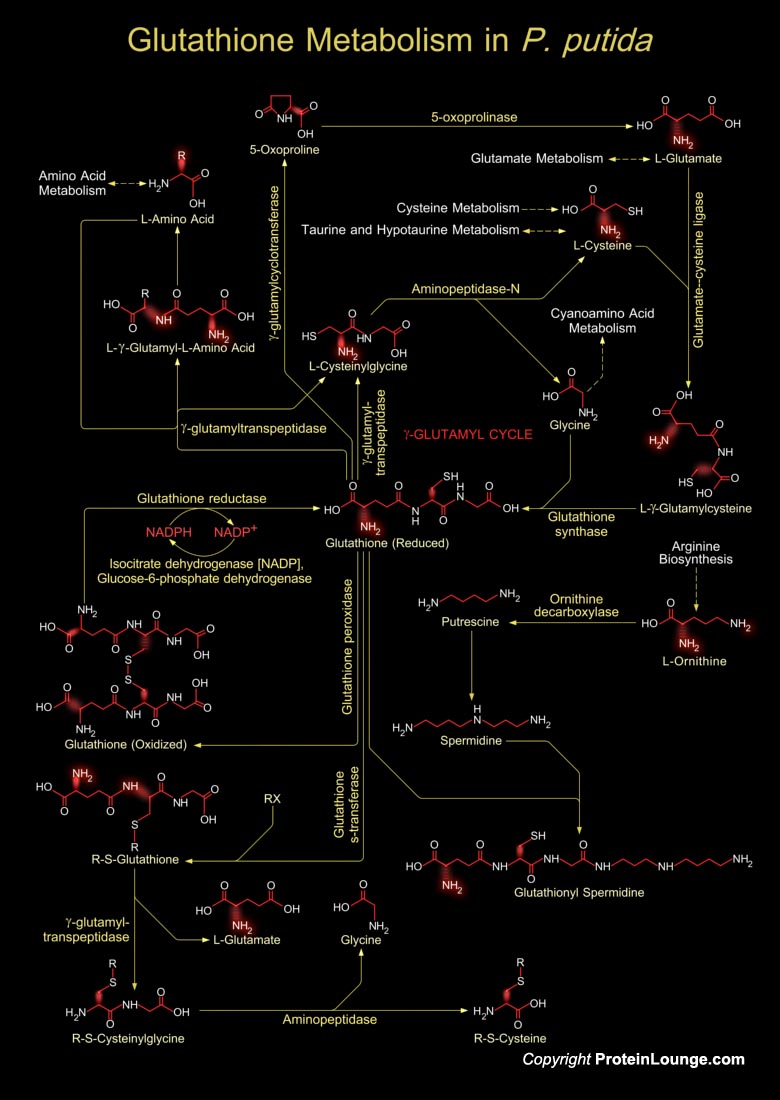
Pseudomonas putida is a Gram-negative, rod-shaped, saprotrophic soil bacterium (Ref.1). It has been reported as opportunistic human pathogens capable of causing nosocomial infections. P. putida exhibits an amazing ability to metabolize a wide range of biogenic and xenobiotic compounds (Ref.2). As a frequent inhabitant of sites polluted with toxic chemicals, P.putida can tolerate high levels of endogenous and exogenous oxidative stress. It is equipped with the enzymatic machinery needed to catabolism both natural and recalcitrant aromatic compounds besides sugars and organic acids. Thiols play several roles in bacteria like maintaining the redox balance, quenching ROS and nitrogen reactive species, and detoxifying other toxins and stress-inducing factors. In[..]

